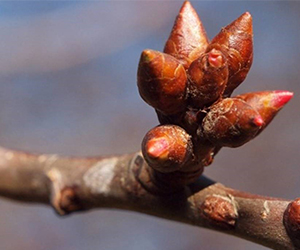As mentioned in part one of this series, an orchard’s ultimate yield is driven by three important factors: number of flowers, the percentage of those flowers that set fruit and the average kernel weight. And, since all these factors build on each other, it’s appropriate that we dive into the place where it all begins — the number of flowers a tree produces.
What is it about what is arguably almond trees’ most beautiful feature that makes them so vital to optimal yield?
“More flowers are better, but it’s not just density. The flower quality is also important because healthy and fertile flowers are more likely to set fruit,” said Sebastian Saa, associate director of Agricultural Research for the Almond Board of California (ABC).
“The quality depends on management during the previous season,” Saa said. “The flowers you see this year began to develop last year, between August and October, so management during that time is critical.”
One key step to fruitful flowering involves keeping a healthy canopy of leaves on the tree after hull split and after harvest so that the tree can continue to gather the energy it needs to develop the buds for the following year’s flowers. Conversely, overly stressing the trees before and after harvest can lead to premature defoliation and have a detrimental impact in flower development.
Because growers irrigate at a deficit to induce conditions that facilitate harvest, the tree is already stressed by harvest, when irrigation is shut down completely. A mild controlled deficit irrigation during this period is fine, but problems occur when the deficit is too long and intense. To prevent early leaf drop, then, growers should irrigate as soon as possible after almonds are harvested, Saa said.
“We understand growers are very busy during harvest and that irrigating can be tricky at that time of year, but trying to irrigate as soon as possible should be a priority,” Saa said. “It’s also a good idea to check your irrigation system to make sure there was no damage to pipes by the harvesting equipment; a heterogeneous water application will get you nowhere.”
Another key driver of abundant, healthy flowers is the number and type of spurs (compacted shoots no longer that 2 inches) on the tree branches. Flower buds are formed on spurs and therefore spurs are the fundamental bearing structure of almond trees. Trees are constantly cycling through these fruit-producing structures — each year some spurs are just beginning to grow, some are “resting” after producing fruit the previous year, others are producing fruit and some are dying after producing fruit in previous seasons.
Observing the trees through the season for spur balance can provide important information for growers. “Manage your trees to keep balance populations of almond spurs. Make sure that your tree has recently formed spurs, spurs producing fruit and spurs resting in any given season,” Saa said.
“For example, if you see no new shoot growth in a given year, this means that your tree is not developing enough new spurs, which could result in a problem for yield two years later,” he said.
Ensuring a good balance of spurs, with fruit for this year and growth for future years, is important to ongoing sustainable yields. Generally, the tree takes care of this balance, so long as it is cared for properly, Saa said. “Imbalance managements — i.e. overuse of water and nutrients — result in an imbalance of spur populations and lack of sustainable yields,” he said.
This balance is particularly important as last season the industry experienced very good yields per acre, which means that a big proportion of the spur population was bearing one or two fruits. Those spurs are likely resting this season and therefore tree bloom may look a bit weaker than last year. At this point, management should focus on securing successful pollination so that fruit set percentage is high.
Saa recommends growers use the California Almond Sustainability Program (CASP) Nitrogen Calculator to guide rates and timing of nitrogen applications. Similarly, the Irrigation Calculator, also available in CASP, will provide to growers key guidance to manage their trees for optimal balance of spur populations and therefore sustainable yields.
To enroll in CASP and access the Irrigation and Nitrogen Calculators, visit SustainableAlmondGrowing.org. Please send your questions to Saa at ssaa@almondboard.com.

Article Image

